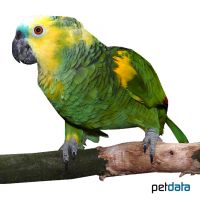Blue-fronted Parrot (Amazona aestiva)
| Blue-fronted Parrot Amazona aestiva | |
|---|---|
| Name | Blue-fronted Parrot |
| Name Lat. | Amazona aestiva |
| Family | Parrots |
| Family lat. | Psittacidae |
| Order | Parrots |
| Order lat. | Psittaciformes |
| Origin | South America |
| Climate | Tropical |
| Diet | Parrot seed, sprouts, veggies, fruits |
| Keeping | Pair, group |
| Care Level | Moderate |
| Reproduction | Cavity nest |
| Life Span | 30-40 years |
| Protection | CITES Appendix II; EC Annex B |
| Metric Units | |
| Size | 37 cm |
| Temperature | Room temperature |
| Housing | 200 x 100 x 100 cm |
| US Units | |
| Size | 15" |
| Temperature | Room temperature |
| Housing | 80" x 40" x 40" |
Distribution and habitat
The range of the Blue-fronted Amazon extends from eastern Brazil to northern Argentina, where they live in palm groves and savanna landscapes with trees, in open forests and cultivated land.
Cage size
The minimum cage size is 200 x 100 x 100 cm (L x W x H) for a pair. The cage size must not be undercut even in case of justified single keeping. For an additional 2 birds, assuming species compatibility, the floor space must be increased by 50%. The cage must be placed at a height of at least 80 cm (except aviaries) in a bright, draught-free and quiet place and should have cross-wiring or netting. Keeping in an aviary with a floor area of at least 2 m² is preferable to keeping in a cage.
Maintenance
The floor must be covered with sand, shavings of untreated wood or similar material and cleaned once a week if possible. At least 2 perches made of wood or branches of different thickness and height shall be installed in such a way as to provide the longest possible flight path. A bathing facility should be available at all times, alternatively they can be sprayed with water at least once a week (e.g. sprinkler system). In addition to hiding places (burrows or half burrows), they need climbing and occupation material, such as rings, ropes and natural branches that are harmless to health. They should be kept at room temperature.
Diet
The species-specific food offer consists of mixed seeds, available in specialized trade as "Parrot food for Amazons" in premium quality, which should also be offered in germinated form, supplemented with green food (dandelion, chickweed, etc.), half-ripe corn cobs, fruits (apples, pears, etc.), vegetables (peppers, carrots, etc.), oil palm fruits, in addition fresh twigs with buds.), half-ripe corn cobs, fruits (apples, pears, etc.), vegetables (peppers, carrots, etc.), oil palm fruits, plus fresh twigs with buds and, especially for raising young, sprouted feed (half-ripe corn) and egg feed. As a digestive aid they need grit, sepia and vitamin lime. Water must always be available in birdbaths or in stable, open containers. Feed and water must be offered fresh daily, and the containers must be cleaned beforehand.
A varied diet promotes health and prevents deficiency symptoms.
Reproduction and breeding
A reliable sex determination is only possible by endoscopy or better by genetic analysis (DNA).
They breed in nest cavities made of hardwood or in hollowed tree trunks. The clutch consists of 3 to 4 eggs, the incubation period is 26 days. The breeding season is, biologically speaking, year-round. During the breeding season they may be kept only in pairs (not in groups). Young birds should be raised so that they are species-specific.
Species protection
They must be identified in accordance with Appendix 6 of the Federal Species Protection Ordinance. The animal population must be reported in writing to the responsible authority immediately after the start of keeping. Your pet store will be happy to provide you with further information.
Species protection: WA Appendix II; EU Appendix B. The proof of purchase is the required proof of origin for the animal. Please keep it safe!
Important
In the case of outdoor aviaries, they also need a heated shelter of at least 1 m², which can be visited by the birds at any time. The temperature in the shelter must not fall below 10 °C and the furnishings must correspond to those of cage housing
They may only be kept in pairs or in a group and not chained or on a hanger. Sufficient daylight or flicker-free artificial light (stroboscopic effect) corresponding to daylight shall be provided in rooms, including shelters. The lighting duration shall be 8-12 hours per day and the natural day-night rhythm shall be observed. Adequate indoor climate should be provided. If caged, they should be allowed free flight. The health condition of the birds should be checked daily.
Further literature can be found in your pet store.
References
Text: Othmar Sieberer; Image: petdata
Source: BMELV (1995): Tierschutzgutachten - Mindestanforderungen an die Haltung von Papageien; ARNDT (1997): Lexikon der Papageien, Arndt Verlag; GRUMMT & STREHLOW (2009): Zootierhaltung - Tiere in menschlicher Obhut: Vögel, Verlag Harri Deutsch
- Gemäß § 21 Abs. 5 Tierschutzgesetz idgF
